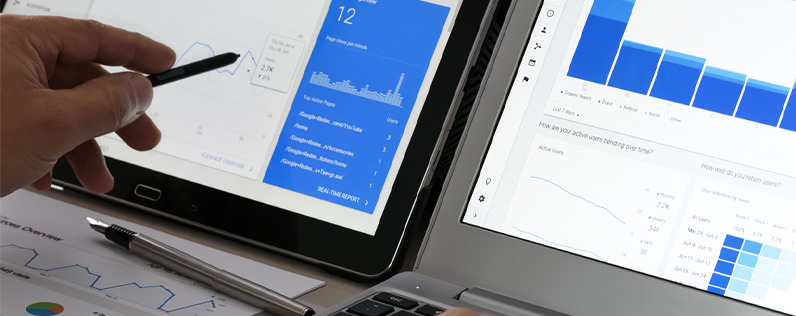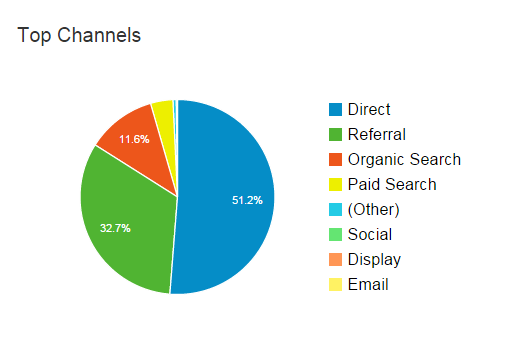You invested time, money, and other resources to set up a website for your business.

It looks great and you’re excited about having a place for people to learn more about your business.
But now that it’s setup, are you able to answer these important questions?
- How many people are visiting your website?
- What pages are getting the most traffic?
- How are people finding your website?
One of the best tools for answering these questions and tracking the effectiveness of your website is Google Analytics.
Google Analytics is a free tool that provides valuable website insights into website traffic, visitor demographics, and other activity that takes place on your site.
Before you get started
Before you get started with Google Analytics, you’ll need to setup a Google Analytics account. When setting up your account, you’ll be asked to give your website URL and will be provided with a tracking code that can be added to any page on your website that you wish to track.
Use these instructions from Google to setup tracking on your site.
Understanding your Google Analytics reports
Once your Google Analytics account has been setup, you’ll have access to a variety of reports that you can use to track your results. You can use these reports to get an overview of your site’s performance, and dig deeper into the metrics to see how this traffic is impacting your business.
Here is an overview of three of the most important reports you’ll want to pay attention to:
1. Audience Overview
The ‘Audience Overview’ heading can be found on the left-hand column of the dashboard. The Audience Overview provides a snapshot of the traffic that’s coming to your site, as well as insight about your audiences’ characteristics. You can filter these results based on the time period you want to measure, and view the results in a monthly, weekly, daily, or even hourly breakdown.
Within Audience Overview you can also see:
- Demographics: Understand the age and gender of your website visitors
- Interests: Understand the lifestyle of your website visitors (e.g. entertainment, cooking, etc…)
- Geo: Understand where your website visitors are located and what their primary language is
- Behavior: Understand your website’s power to turn new visitors into those that return as well as their engagement while on your site
- Technology/Mobile: Understand the mechanism or platform that your website visitors are using to access your site (browser, OS, smartphone, iPad)

How to use the Audience Overview
Identify high trafficked days & popular content: The chart above is what a sample business may see, but if you notice that yours looks a bit more rigid, with occasional spikes, focus on those moments. What could have caused this jump in views?
Some possibilities include:
- A media placement or mention in a widely-read publication
- A popular blog post, re: your personal story of starting your business
- A messaging change to your website
2. Acquisition Overview
The Acquisition Overview heading can be found along the left-hand column of the dashboard as well. While the previous tool, Audience Overview, will give you an idea of who is visiting your business online, your Acquisition Overview will tell you what your audience is searching for related to your business, and where your website visitors are coming from.
Within Acquisition Overview you can also see:
- Top Channels: This provides a breakdown of the different channels people are using to discover your website (including search, social, or referrals from other websites).
- Keywords: Google will show you a limited view into which keywords people are using to find your website through organic search.
- Social Media: See which networks are generating the most traffic back to your site, and which pages are being shared on social media.

Along with these tools for tracking organic traffic, you can also view insights into how your different campaigns are performing if you decide to invest in Google’s paid advertising options.
How to use the Acquisition Overview
Understand the market:
Within Acquisition Insights, click ‘Search Engine Optimization’ (a subheading on the left-hand column) and then Queries where you will find a list of the top ten search terms that people use on Google search to find your business. If you want a certain keyword to be more prominent within the search rankings, start working it into your website strategy.
Learn the SEO basics you need to optimize your pages for organic search.
3. Behavior Insights
Along the left-hand column, click on the ‘Behavior’ heading. Here, you’ll learn more about your website’s most popular pages, each page’s bounce rate (rate at which someone leaves your home page without interacting or browsing further), and how long your users stay on your site before leaving.
Some of the different reports within Behavior Insights, include:
- Site Content: See what pages are generating the most traffic, and which pages are resulting in the highest number of people entering and exiting your site.
- Site Speed: Learn more about the load time of your different pages, and see how these load times are impacting activity within your site.
- Site Search: If you setup a custom search box within your website, you will be able to see a snapshot of the keywords being used by site visitors.
How to use Behavior Insights
Understand audience engagement (or disengagement):
The information you will find within ‘Behavior Insights’ can indicate whether your website’s content is meeting the needs of your visitors (and likely, those who could be current and/or potential customers). Perhaps your ‘services’ page on your website isn’t performing the way you had anticipated. Or the number of drop-offs on your landing page is increasing.
To better meet the needs of your visitors, think about how you can make improvements to your site’s content and design. Maybe your product offerings or services aren’t made clear, or your design is not mobile-friendly. Explore some tactics to turn things around so that your content is easy-to-digest on any device.
Try Google Analytics for yourself
Once you’ve setup your Google Analytics account, take some time to explore your Analytics to see if any details stand out.
You can use these insights to make improvements to your website and can also use the data in Google Analytics to tweak your strategy for your email marketing, blog posts, social postings, and public relations efforts depending on your business needs.
Google Analytics can assist you be a better marketer, and align your offline activity with how your brand is being consumed on the web.
We suggest visiting your Google Analytics dashboard on a regular basis, perhaps monthly, to continue to implement changes and better connect with your customers. Start by setting up your Google Analytics account, applying the tracking code to your website and understanding the primary dashboard. Best of luck!
Need more advice on navigating Google Analytics? Take a look at this quick chart.




